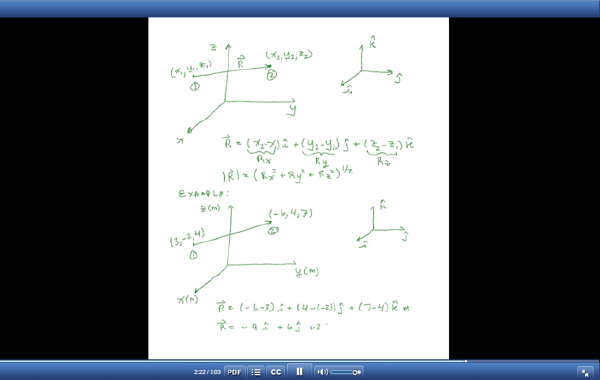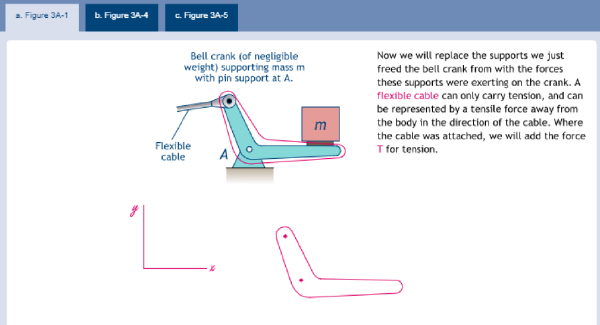
Engineering Mechanics: Statics, 9th Edition
By James L. Meriam, L Glenn Kraige, and Jeffrey N. Bolton
Known for its accuracy, clarity, and sound pedagogy, Engineering Mechanics: Statics has empowered students to develop a solid foundation of mechanics principles for more than 60 years. Now in the new WileyPLUS platform, this course offers a wealth of resources to provide ‘just in time’ scaffolded learning support, enabling students to dig deeper into each lesson and achieve a greater understanding of topics during their study sessions, building on the sound foundation they receive in class. Students build necessary visualization and problem- solving skills emphasized by drawing free-body diagrams
—the most important skill needed to solve mechanics problems.
Want to learn more about WileyPLUS? Click Here

Students learn how to use common math to solve complex problems.
Video Tutorials provide explanations of a specific math or geometric method that is commonly used to solve problems in the chapter via a whiteboard and voice-over.

Animations bring concepts to life for students.
Drawing Free Body Diagrams is a critical skill to success in this course. Animated Figures provide students with step by step instructions explaining each component of a Free Body Diagram to overcome intimidation.

Videos help students build problem-solving skills.
Approximately 200 new Video Solutions walk students through a detailed step-by- step problem-solving process– both on a whiteboard and voice-over.
Features Included:
- Algorithmic Problems: Over 1,500 algorithmically generated homework problems give each student unique values and reduce the chance of students cheating on assignments. Students receive immediate feedback as well as links to the text to build student confidence and reinforce skills.
- Reserve Assessment Problems: Reserve Assessment Problems are not available to students unless they are assigned by an instructor, making solutions more secure. Hundreds of Reserve Assessment Problems are already available, and more will be added over time.
- “What an Engineer Sees”: Animations walks students through real-world scenarios – allowing them to connect theory and idealized line drawings to the real world.
- Multi-Step and Guided-Online (GO) Tutorials: Tutorial problems provide additional guidance to students on how to break down a complex problem into appropriate problem-solving steps.
- Foundations Adaptive Practice: Provides just-in- time support for students on key pre-requisite topics in mathematics and physics.
- Student Practice Modules: These modules allow students to reinforce what they are reading as they go, while practicing on their own with:
- Approximately 100 Check Your Understanding questions.
- Approximately 100 automatically-graded problems and the ability to check their work with official step-by-step solutions (text or video format).
What’s New
- Student Practice Modules: These modules include hundreds of Check Your Understanding questions and problems, giving students the chance to check their work against the official solution.
- QuickStart Assignments: These are pre-created homework assignments that instructors can either assign “as is” or easily modify.
- Algorithmic Automatically-Graded Problems: Auto-graded, randomized homework problems use techniques such as hints, partial solutions, and progressive complexity to build student confidence and reinforce skills.
James L. Meriam (1917–2000) was one of the premier engineering educators of the twentieth century. He earned his B.E., M. Eng., and Ph.D. degrees from Yale University and had early industrial experience with Pratt and Whitney Aircraft and the General Electric Company. During the Second World War, he served in the U.S. Coast Guard. He was a member of the faculty of the University of California-Berkeley, dean of engineering at Duke University, a faculty member at the California Polytechnic State University-San Luis Obispo, and visiting professor at the University of California-Santa Barbara, retiring in 1990. He was the first recipient of the Outstanding Faculty Award of Tau Beta Pi. In 1978, he received the Distinguished Educator Award for Outstanding Service to Engineering Mechanics Education from the American Society for Engineering Education. In 1992, he received ASEE’s Benjamin Garver Lamme Award, its highest annual national award.
Glenn Kraige, co-author of the Engineering Mechanics series since the early 1980s, has made significant contributions to mechanics education. Kraige earned his B.S., M.S., and Ph.D. degrees at the University of Virginia, principally in aerospace engineering, and he is professor emeritus of engineering science and mechanics at Virginia Polytechnic Institute and State University. His outstanding teaching has been widely recognized and has earned him numerous teaching awards, including the Outstanding Educator Award from the State Council of Higher Education for the Commonwealth of Virginia in 1988. In 1996, the Mechanics Division of ASEE bestowed upon him the Archie Higdon Distinguished Educator Award. The Carnegie Foundation for the Advancement of Teaching and the Council for Advancement and Support of Education awarded him Virginia Professor of the Year for 1997.
Jeffrey N. Bolton, assistant professor of mechanical engineering technology at Bluefield State College, is the new co-author of this edition. Bolton earned his B.S., M.S., and Ph.D. in engineering mechanics from Virginia Polytechnic Institute and State University. His research interests include automatic balancing of six-degree-of-freedom elastically-mounted rotors. While teaching at Virginia Tech, he was the 2010 recipient of the Sporn Teaching Award for Engineering Subjects, which is an award primarily chosen by students. After joining the faculty at Bluefield, Bolton was selected in 2014 as the Bluefield State College Outstanding Faculty of the Year based in part on his effective use of technology in lecture delivery, lecture capture, and assessment of student learning. In addition to the above achievements, Bolton brings to this series a wealth of experience in utilizing technology in the engineering classroom to foster student success.
1. Introduction to Statics
2. Force Systems
3. Equilibrium
4. Structures
5. Distributed Forces
6. Friction
7. Virtual Work
8. Area Moments of Inertia
9. Mass Moments of Inertia
10. Selected Topics of Mathematics
11. Useful Tables

